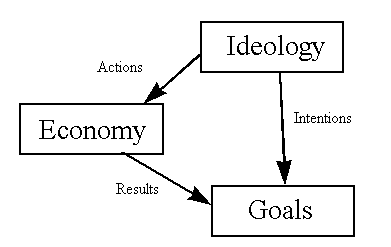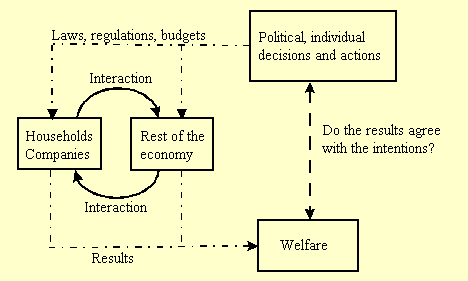
| 1. Introduction | 21 June 1999
To contents |
Macro economics is closely connected to politics. Hence the traditional term "political economy". Political decisions have an aim that often is achieved by economic policies. Decisions are taken about tax rules or public expenditures. The preconditions for the activities of companies can also be regulated.
Economic events do not just happen, they are the result of decisions taken by human beings. People act as individuals and all small decisions are taken in the framework of our laws. Managements of companies and boards of organizations have more power and their decisions can cause devaluation of currencies, new legislation or even overthrow governments. Individuals, employees and companies have their organizations that try to influence the politics. Parliaments and governments have the political power and decide about laws and budgets. Local communities decide about health care, schools, communications etc.
The results of the decisions eventually show up as employment, production of goods and services, infrastructure, education, welfare, income distribution, depletion of natural resources and famine in some areas the world (1).
The relation between politics and economy is outlined in the diagram below:

Figure 1.1:1 Politics and economy.
The figure shows how politics influences the economy. Ideology is a theoretical framework for the general goals of political parties and other groups in the society. The ideology determines in general terms how different parties will act in economic issues. These actions are inputs to the economic system and as the economy evolves the results will show up. The results are in the best case in agreement with the goals of the ideology that initiated the process.
Different ideologies and interests are active in most political systems. The decisions are often a compromise between different interests and different decisions do not always lead to a common goal. However, the individuals and organizations may have goals that are contradictory to the political intentions.
Disagreements often come from different goals, but also from different
meanings or beliefs about what the result will be from a specific
action. This study tries to formulate a theory that will establish
the relation between inputs (decisions and actions) to the economic
system and the outputs (results). One action taken in one place
of the system will eventually spread out to the whole system in
a complex manner. If one individual or one company takes an action,
this will in general have a very limited effect to the system
and can often not be measured. If all people, all companies or
a very big company behaves in a certain way, the whole system
can be influenced and the impact can hit the actor from behind
(feedback).

Figure 1.1:2 Interdependencies inside the economy and
with the political system.
Micro economic theory deals with actions within one sector of the economy (Households, Companies, Rest of the economy in figure 1.1:2) at a time. The restrictions and consequences for the actors are analyzed assuming an essentially constant economic environment. Price-output relations and equilibrium on different markets are of special interest.
Macro economic theory has to consider feedback in the system.
A change in one part of the system will have impact on the whole
system and change the environment of the sector in which the original
change took place. The different sectors interact by payment flows,
resource flows and prices.
All theory makes simplifications and describes only one aspect of real life. It constitutes a model of reality. The theory for economic circular flows is a method for building mathematical models of economic systems on a macro economic level.
The models can be designed with different degrees of detail. Depending upon the degree of detail, different properties and behaviors can be analyzed and simulated. This first part of the theory deals with static models, a second part will elaborate the theory for dynamic models.
The theory is based upon engineering methods for circuit theory and control systems. Main concepts are flows, components, input signals and output signals. The flows of technical systems are water, steam, electrical current and so on. The flows of economic systems are payments and resource flows such as raw material, energy, labor, waste, goods and services. The components of the economy are not resistors or capacitors but the different sectors of the society: enterprises, public sector, households, financial sector and foreign countries. Input signals are decisions about spendings, loans, interest rates, wage and salary levels and so on. The outputs are production volumes of different goods and services, budget surplus or deficit, profits, employment and unemployment levels and income distribution.
The interdependence between the different sectors of the economy requires that a great number of simultaneous equations are used. Linear algebra and matrix methods are used to solve the equation systems that describe the static models. The single equations are often very simple, it is the combination of many equations with many variables that makes it possible to analyze the complex interdependencies of the different parts of the economy.
The analysis and simulation of dynamic models requires systems
of differential equations or difference equations. The dynamic
equations will form a "shell" on the static equations,
see appendix A2 and ref. (2).
All economic systems are basically dynamic, i.e. they evolve in time. Static models can show snapshots of the economy and can be used to show possible combinations of economic variables at a certain instance in time. The difference between two instances in time (states of the economy) can be calculated by varying the input data, but static models do not tell how the economy will develop or if it is possible to come from one state to another. If it can be assumed as plausible that a change will lead form one state to another, then it is possible to estimate the probable result of an economic measure.
Part 1 of the theory describes static models. The first models of macro economic systems are mainly based on definitions. The definitions are explained in basic textbooks (3) and (4).
Chapter 2 describes the basic principles needed for building static models. Chapter 3 will treat input-output models and general equilibrium models from the literature. Chapter 4, "Calculation example with Swedish economic system, Model S1", shows a simple example of how an economic system can be described by payment balances and relations between payment flows, described by model equations. Each economic sector has one payment balance equation and none or more model equations. The equations for a specific sector uses only flows to and from that sector. It is crucial to choose appropriate model equations. The model parameters should be nearly constant when other parameters vary. Different choices of model equations can give seemingly contradictory results.
In chapter 5, the model is extended to include investments, exports and imports. This model (S2) comprises the payment flows of the gross domestic product GDP = C + I + G +(X-IM). Historical data, from Statistical Yearbook of Sweden, is shown in diagrams from which the model parameters can be extracted.
Chapter 6 reviews the economic circular flow diagrams of some basic text-books.
Chapter 7 (Model S3) divides the households in five categories: pensioners, unemployed, public employees, private employees and capital owners. Transfers and profits are also included. Chapter 8 shows simulation results from model S3. The influence of profits, taxes and economic growth is shown in detail. Chapter 9 rewrites the same model with eight separated payment flows.
Chapter 10 describes the real flows of goods and services. The price of commodities and productivity is treated. A simplified static model of the financial sector will be described in chapter 11.
The rest of the theory for static models remains to be elaborated. The previous chapters 11 and 12, treating dynamic models, will be moved to Part 2 Dynamic Models.
Most interesting phenomena in economy are dynamic e.g. economic growth and economic cycles. It is necessary to calculate the dynamic behavior of an economic system in order be able to study the result of economic decisions. Note that it is not possible to make regular forecasts, only possible scenarios can be set up. By making a scenario, all input signals to the economy may be decided and the development can be calculated under the given conditions.
I started to make a dynamic model called D1. Now I have decided to leave that theory until later and resume the work when Part 1 Static Models and the basic parts of Part 2 Dynamic modes have been done.
The previous chapter 12 shows the first dynamic model (D1). It includes employers contribution to social security, indirect commodity taxes, transfers and fees, a financial sector and flows of goods and services. The number of employees in private and public sectors are calculated as a function of time. The other flows follow in the process.
Model D1 will be followed by models comprising saving and borrowing
accounts, interest payments, stock market, capital movements,
exchange rates and money-issuing. Then it will be possible to
simulate most of the issues of the economic debate, among them
the unemployment rate.
My first model from 1996, "Model 1" (only in Swedish), gave results well in accordance with historical experience. It can calculate the relation between unemployment and inflation (the Phillips curve), distribution of income and gross national product. The mathematical method used was plain algebra for successive calculation of the unknown entities. The matrix method now adopted is more general. The, for the moment, largest model (D1) has 39 flows. These flows can only be calculated by solving an equation system.
This theory is incomplete. It should be regarded as an invitation to fill the gaps. I now plan to elaborate Part 1 of the theory, Static Models. It will have some 20 chapters including the analysis of models used by governments, such as the Swedish KOSMOS (5) and the Australian ORANI (6) models. Part 2 for Dynamic Models will be started later this year (1999).
My original ideas are described in the project description . The thesis document has suggestions for students work.
I will try to add some exercises to each chapter. I do not publish any answers at the moment but readers are welcome with their suggestions to my e-mail. If the reader wishes, I can add the answers to this document. I reserve the right to add my own comments to the answers. If contributors wish, I can also, as far as I have time, return personal comments by e-mail.